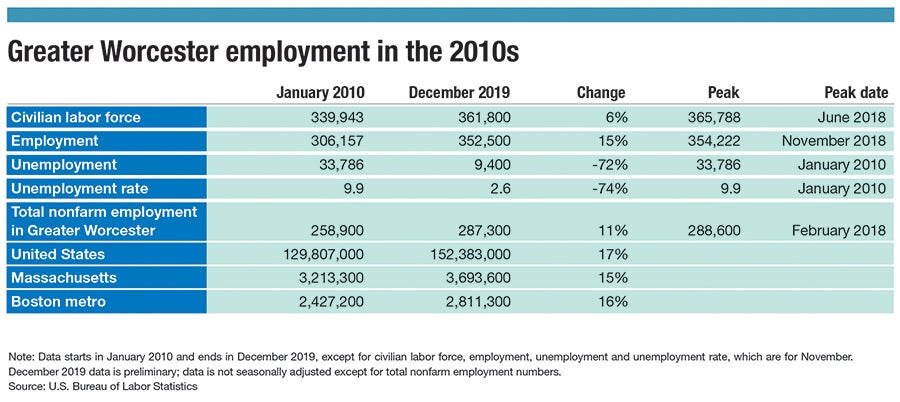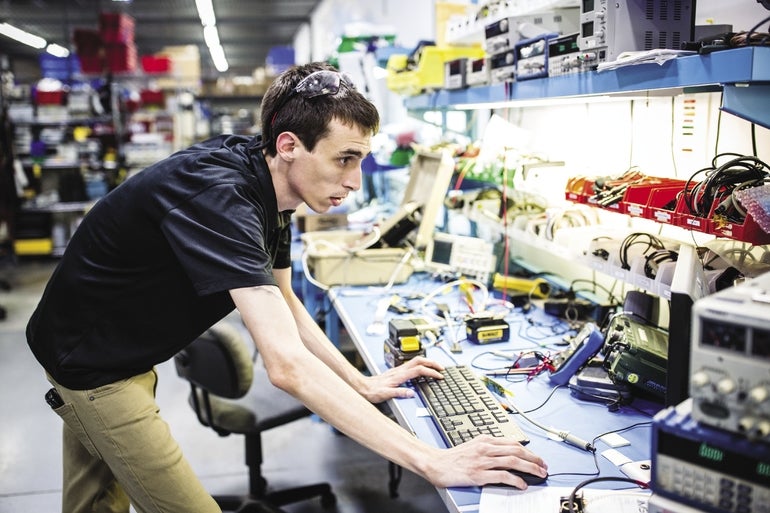There was nearly one constant across the 2010s in the Greater Worcester workforce: Jobs became more plentiful, in nearly every industry.
Get Instant Access to This Article
Subscribe to Worcester Business Journal and get immediate access to all of our subscriber-only content and much more.
- Critical Central Massachusetts business news updated daily.
- Immediate access to all subscriber-only content on our website.
- Bi-weekly print or digital editions of our award-winning publication.
- Special bonus issues like the WBJ Book of Lists.
- Exclusive ticket prize draws for our in-person events.
Click here to purchase a paywall bypass link for this article.
There was nearly one constant across the 2010s in the Greater Worcester workforce: Jobs became more plentiful, in nearly every industry.
Education and health services – responsible for one out of every four jobs in the Worcester metropolitan area, higher than even the Boston area – added nearly 13,000 jobs. That pace was multitudes larger than any other industry in the area, according to U.S. Bureau of Labor Statistics data.
Smaller sectors also gained, including construction, which added 61% more jobs over the decade, and professional and business services, which grew by more than one-tenth.
Not every sector had the same success.
Manufacturing jobs and financial activities each lost around 1% of their jobs, even as the Worcester metropolitan area’s total nonfarm employment grew 11%. BLS defines Greater Worcester as Worcester County and Windham County, Conn.
There’s one unequivocal point: The decade closed in a much better spot than it began.
January 2010 had an unemployment rate of 9.9%, with nearly 34,000 people out of a job and searching for work. Neither number would be so bad again.
Eight strong years and two flat years
Employment numbers rose and rose through much of the decade to the point where today employers often can’t find enough qualified workers, those in career services say.

“It’s obviously a very competitive market for labor and talent,” said Jeffrey Turgeon, the executive director of the MassHire Central Region Workforce Board in Worcester.
Still, the line of improvement hasn’t been continuous.
Nonfarm employment – the most common measure of the workforce – peaked in February 2018 and has fallen in 13 of the last 22 months since.
Greater Boston, on the other hand, peaked in August 2019 and barely dropped since. Springfield, Brockton, Lowell, New Bedford and other metro areas have continued rising employment.
In fact, each of those areas have had steeper employment increases throughout the decade than the Worcester area did.
Worcester's recent decline is also a sharp contrast to Massachusetts as a whole, where employment is up nearly 2% over the last two years, or nationally, where it's closer to 3%.
At the jobs website ZipRecruiter, labor economist Julia Pollak called the decline in employment in the Worcester area startling. It was surprising enough, she said, that ZipRecruiter’s staff, upon reviewing the workforce data, thought business closures were to blame.

The drop in the Worcester area, though, appears to be due to a broader decline in demand for workers.
“Job growth came to a grinding halt in 2018 and 2019 in Worcester, even as it remained robust in most of the country,” Pollak said.
Low job-posting volumes could suggest further job loss this year, she said.
Job openings in the Boston area could be on the way down, too, at least according to the job site Glassdoor. On Glassdoor, Greater Boston openings have dropped by more than 10% from a peak of more than 160,000 in September. Openings fell almost 1% for the year.
Key industry lags
No major industry has struggled overall more than manufacturing.
Manufacturing jobs not only haven’t recovered since the Great Recession, they’re a fraction of what they used to be.
Greater Worcester had 51,900 manufacturing jobs in April 1990. Since then, the number of such jobs has fallen by nearly half to 27,900. Even from September 2008 – the month the financial services firm Lehman Brothers filed for bankruptcy and the Great Recession started in earnest – to October 2019, Worcester manufacturing jobs are down 13%.

Despite the job losses, manufacturing remains the largest industry in Greater Worcester when measured by economic output: manufacturing generated $6.9 billion in gross domestic product in 2017, accounting for 16% of the economy; health and education was next at $6.1 billion.
Where manufacturing takes up the greatest share of jobs locally – the North County region anchored by Fitchburg and Leominster – the industry did better. The North Central Massachusetts Chamber of Commerce commissioned a study, which found a 6% increase in the manufacturing workforce in the area, which includes some communities outside Worcester County.
“We make stuff here in North Central Massachusetts,” said Roy Nascimento, the chamber’s president and CEO.
But the region is bound for a major challenge in the industry. Its average workers’ age is 55, the chamber found.
With the aging workforce in mind, the MassHire North Central Workforce Board began a career training program with local community colleges and adult education programs. In the first year, 162 people were trained to enter the workforce, said Beth Goguen, the director of the MassHire office in Leominster.
A MassHire office in Marlborough has been working to help manufacturers find workers, too, including holding a workforce summit
“Wages, however, are really good,” said Greg Bunn, the executive director of the Metro South/West MassHire office, “as there has been more and more demand for computer and mathematical skills over assembly-type skills.”
Eds & meds surges ahead
Education and health services – the so-called eds & meds public officials love to tout — grew at roughly double the rate of the workforce overall.
“By focusing on areas where we are at an advantage, we can build on our strengths,” said Kathy Kiel, an economics professor at the College of the Holy Cross in Worcester. “The question will be whether the demand for the products produced by those sectors will remain strong – and it seems likely that they will.”
Fiscal constraints have held back workforce growth at some major health employers, including UMass Memorial Health Care in Worcester, and Greater Worcester colleges are working to adapt to changing demands in higher education at a time when industry observers expect some smaller schools to close.
And healthcare employment locally has essentially flattened in the past two years — growing less than 1%. Statewide, it’s almost 3%.
Still, healthcare jobs could continue to grow rapidly in the region, especially with an aging population. The Bureau of Labor Statistics has projected a 14% growth in healthcare jobs from 2018 to 2028.

